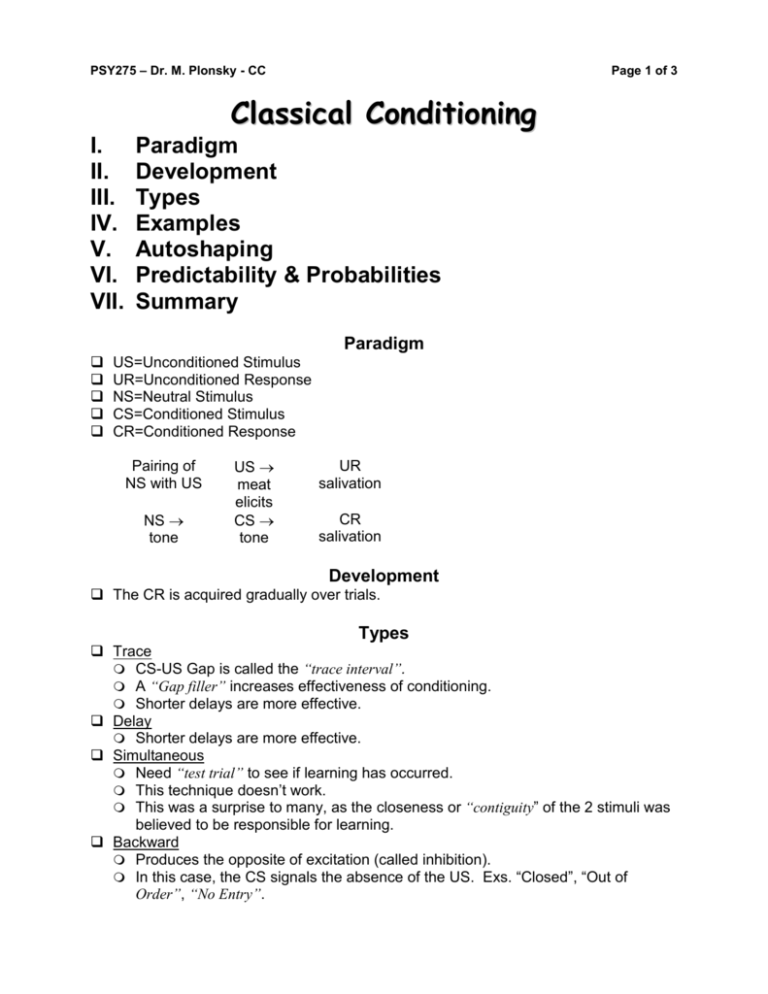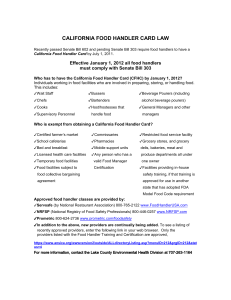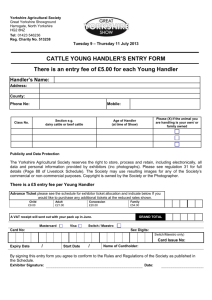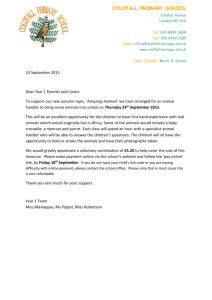Classical Conditioning
advertisement

PSY275 – Dr. M. Plonsky - CC Page 1 of 3 Classical Conditioning I. II. III. IV. V. VI. VII. Paradigm Development Types Examples Autoshaping Predictability & Probabilities Summary Paradigm US=Unconditioned Stimulus UR=Unconditioned Response NS=Neutral Stimulus CS=Conditioned Stimulus CR=Conditioned Response Pairing of NS with US NS tone US meat elicits CS tone UR salivation CR salivation Development The CR is acquired gradually over trials. Types Trace CS-US Gap is called the “trace interval”. A “Gap filler” increases effectiveness of conditioning. Shorter delays are more effective. Delay Shorter delays are more effective. Simultaneous Need “test trial” to see if learning has occurred. This technique doesn’t work. This was a surprise to many, as the closeness or “contiguity” of the 2 stimuli was believed to be responsible for learning. Backward Produces the opposite of excitation (called inhibition). In this case, the CS signals the absence of the US. Exs. “Closed”, “Out of Order”, “No Entry”. PSY275 – Dr. M. Plonsky - CC Page 2 of 3 This is why it is important to give the praise cue before, rather than after the reward. Temporal This form of conditioning produces both excitation & inhibition. Examples Dinner time excitement (will give handler reminders) Dinner preparation routine (handling bowls, etc.) salivation Leash unclipped freedom Tracking line nose to ground Men (to some dogs) fear (perhaps abuse history) Handler corrections avoidance &/or aggression to handler Toy fun, excitement Putting on my running shoes fun, excitement Traveling to familiar training areas whining just before getting there Words: Feedback – good &/or yes, eh/no Activity – play, swim, go outside Doorbell/knock stranger Equipment used in training eagerness/excitement Helper/Decoy freezes automatic out “This is the ___ police department, come out now or I’ll send my dog” dog (& handler) get “pumped” Autoshaping (& Sign Tracking) Pigeon “teaches” itself to peck a disc. Pairing of NS with US NS lighted disc US food elicits CS lighted disc UR pecking CR pecking Animals tend to approach & contact stimuli that signal the availability of food, hence the term “sign tracking”. This is part of what is going on in “luring”. Can also be done with rats - The rat treats the bar as if it was the food and tries to eat and chew the bar resulting in it being pressed. Can also be done dogs - Pamela Reid with retrieve. Predictability & Probabilities Issue is whether the CS predicts the US. A contingency refers to a dependence of one event upon another. Consider the probability of an event: If P=0, event will not happen. PSY275 – Dr. M. Plonsky - CC Page 3 of 3 If P=1 event will happen. If 0>P<1, event may happen. Most events fit in here. Now, there are 2 probabilities we need to consider: 1. P(US/CS) - probability of the US occurring given that the CS has occurred. 2. P(US/NoCS) - probability of the US occurring given that the CS has not occurred. Possible Emotions - Possibilities for what is going on inside the black box: US Type Pleasant Aversive CS+ Excitation Joy Distress CS- Inhibition Sorrow Relief Summary 1. CC is concerned with “what predicts what”. More specifically, it is concerned with events (stimuli) in the world that predict the occurrence of biologically important events (food, pain, fun). Thus, CC deals with relations between stimuli (S-S relations). 2. CS comes to be treated as if it were the US. 3. There is an emotional component.



